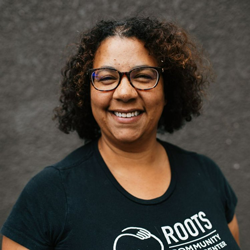Building Birth Centers in Less Populated Areas
It can be even more challenging to build birth centers in areas where the population is more dispersed. In New Mexico, where three-quarters of all births are covered by Medicaid and nearly one in five people lives in poverty, finding a location near pregnant people, midwives, and the hospitals needed to handle transfers is particularly tough, especially when the people you want to serve live in remote areas, including Indian reservations.
Nicolle L. Arthun, MSN, CNM, a Dine’ midwife from the Navajo Nation, founded the Changing Woman Initiative eight years ago in Albuquerque, N.M., with the goal of creating a center that embraced the unique birthing traditions of Indigenous people. “There’s a whole fabric of stories and language and songs and protocols that we should be following,” she says. The ceremonial pieces of Indigenous birth and prenatal care don’t easily align with rigid appointment slots generally used by health care systems.
Arthun also found other Indigenous traditions are not easy to accommodate in hospitals, such as burning cedar or sage and having multiple family and community members, including a medicine man, present at the birth. “It didn’t make sense to try to merge traditional wisdom knowledge practices into a system that was not prepared to adopt them or to make space for them,” Arthun says.
Finding a site to build upon was equally challenging. She was hoping to find land that could accommodate a hogan, an octagonal structure with a fireplace in the center and dirt floors, and also have room for a garden to grow medicinal herbs and food for large families that gather for the birth. She and her partners — three other midwifes — spent years on plans to build a facility on tribal land but had to scrap the idea because they couldn’t afford the monthly rent for the proposed four-acre site.
They then considered building in Santa Fe, but that proved too expensive and too far for staff and patients to travel. A final study determined it would cost roughly $2.5 million to build a center closer to Albuquerque, a goal they never reached owing to the difficulty of fundraising. Arthun says she would write as many as 10 grant proposals a month but never raised more than $100,000 a year, because there’s little funding for maternal health and even less for projects geared to Indigenous populations. “We need a larger investment to be sustainable and also to expand the work.”
Arthun has stepped back from the organization to help birth centers in cities where market conditions are more favorable. Her colleagues continue to provide care via home births.
Next Steps
Ensuring birth centers can thrive in all markets will require more collaboration between the public and private sectors to address funding impediments. Here are some of the ways policymakers, philanthropists, and investors could come together to tackle five of the biggest challenges.
Strengthening the Midwifery Workforce
In 2021, fewer than 1 percent of births occurred in birth centers. As more people elect to use to freestanding birth centers or have home births led by midwives, the U.S. will need a comprehensive strategy to ensure it has the workforce to meet growing demand.
Expanding the workforce requires coordinated investments in education programs and adjustments to loan repayment programs to encourage midwives to work in underserved areas. Arthun says her midwives couldn’t qualify for loan repayment because the program would require them to locate their offices in a remote area that had an insufficient number of patients to sustain a practice.
Funding education programs directly sidesteps this challenge. The Health Resources and Services Administration recently awarded the University of Michigan a $4 million grant that enables the school to offer full scholarships to midwifery students living or working in underserved areas. The Michigan Maternity Care Traineeship Program’s first cohort of 13 students begins this fall and will rotate through Birth Detroit.
Hospitals also may need to be incentivized to hire midwives, including those in training. Mimi Niles, PhD, MPH, CNM, an assistant professor at New York University’s Rory Meyers College of Nursing who studies the midwifery workforce, says hospitals have little incentive to do so now because they will be reimbursed more for physicians who are providing the same level of care.
Increasing Access to Capital
The birth centers that have made the most progress have benefited from lower land costs, cooperative hospital or real estate partners, and supportive payment policies. Still, they rely heavily on grassroots fundraising. To support innovators who need capital and technical assistance, Baril and Welch launched Birth Center Equity (BCE) in 2020. Now led by Welch, the organization has distributed $2.2 million in grants, loans, and other investments in birth centers. BCE is currently raising money for a “business studio” that will bring experienced entrepreneurs, subject-matter experts, and investors together to design and launch solutions for birth centers’ real estate, marketing, and other business needs.
BCE is also partnering with Orchid Capital Collective, a nonprofit based in Oakland, Calif., that aims to provide community-based organizations, including birth centers, with access to financial supports, including recoverable grants, below-market loans, and loan guarantees. Orchid Capital launched a $1 million pilot fund last year, with plans to make as many as seven investments this year, ranging from $50,000 to $250,000. The organization also provides capacity-building grants and technical assistance.
To date, Orchid Capital’s funding has come from private foundations. Far more is needed, both from investors and philanthropists who recognize the importance of making simultaneous investments in care models that prioritize healing and wellness, social supports, and advocacy and policy reform, says Tenesha Duncan, MBA, Orchid Capital’s founder and CEO. “In the next decade, I want to see at least $1 billion committed to BIPOC-led organizations. And to be clear, to hyper-local organizations and statewide and regional coalitions that are collaborating to grow a deeply connected national ecosystem,” she says.
Role of Policymaking
Overhauling payment to support proven birthing models is also key. The new Transforming Maternal Health Model, announced by the Centers for Medicare and Medicaid Services (CMS) in December, will provide participating state Medicaid agencies $1.7 million per year over a decade to test innovative models of care that improve maternal health outcomes. “By demonstrating the value of these models, the pilots have the potential to reshape payment and care,” says Jennifer E. Moore, PhD, RN, executive director of the Institute for Medicaid Innovation, a nonprofit that runs a Commonwealth Fund–supported collaborative to bring together providers, payers, policymakers, and philanthropists interested in improving maternal health.
While these short-term investments help, they don’t address a fundamental challenge that birth centers have: their size. With a low volume of patients, they have had little leverage with managed care plans, especially ones reluctant to design new contracts for facilities serving a small number of patients. They also don’t receive disproportionate share payments some safety-net providers receive to offset low Medicaid reimbursements. New Medicaid managed care regulations that set new access standards and allow for increased payment rates for primary care, obstetric services, and mental health services might help birth centers as they negotiate inclusion in managed care networks at fairer rates.
Some states are trying to address the payment issue. In September, Oregon’s Medicaid agency sought permission from CMS to raise the facility fee for freestanding birth centers threefold, from $1,200 to $3,700. And in January, Washington State increased the facility fee for birth centers to $2,500 for fee-for-service Medicaid births, more than double the amount in 2016. The Medicaid agency also pays midwives and physicians the same professional fee, regardless of birth setting, for the same level of care.
Birth centers in other states may need local allies or changes in state policy to compel payers to treat birth centers and their staff equitably. “We have to stop having bake sales to sustain birth centers,” Moore says.
Building Public Interest and Trust in Birth Centers
Moore believes the biggest driver of change will be consumer demand, but that may require an awareness campaign aimed at educating the public about the value of midwifery and birth center care and overcoming distrust. “Without structural analysis, the headlines surrounding Black maternal deaths frighten people,” Baril says. ”They tell us, ‘I’ve heard Black women are more likely to die in childbirth — why do you want to take us out of the hospital?’”







